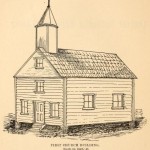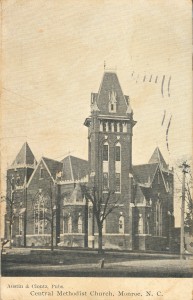Church History
The “society” that became Central Church was probably formed in May of 1843, when the Rev. W.A. McSwain preached to a handful of believers at Winchester’s store. The County of Union had just formed the previous December; the very next month the county commissioners bought seventy-five acres for the county seat. The first plat of the town square shows the location of the church on the southeast corner of Church and Windsor Streets; it was simply marked “church” because it was the only church there until the 1880’s.
 The first official record of the Methodist Church in Monroe was a payment of $3.05 for ministerial support, dated on August 9, 1844. Thus it is that we celebrate 1844 as the founding year for our church. Church members built a log house of worship on Windsor Street, which they used for thirty years before selling it to the new Presbyterian Church and moving west to a new building on the northwest corner of Windsor and Hayne Streets.
The first official record of the Methodist Church in Monroe was a payment of $3.05 for ministerial support, dated on August 9, 1844. Thus it is that we celebrate 1844 as the founding year for our church. Church members built a log house of worship on Windsor Street, which they used for thirty years before selling it to the new Presbyterian Church and moving west to a new building on the northwest corner of Windsor and Hayne Streets.
The devastating results of the War Between the States and Reconstruction were replaced by an explosion of growth in the local population and economy. In 1865 the Monroe Church became a paying appointment after being on a circuit for over twenty years. It was named the Monroe Methodist Episcopal Church, South, the two branches of Methodism having split before the war.
 By the end of the century the Methodists were ready to expand again. The cornerstone of a beautiful brick Gothic building was laid in 1900, and the congregation moved across Hayne Street to its fine new edifice in July of 1902. The Board of Stewards voted to change the name of the church to Central to coincide with the opening of the new building. Space was needed for a growing church and so an education building was added in 1921. A new parsonage was also built.
By the end of the century the Methodists were ready to expand again. The cornerstone of a beautiful brick Gothic building was laid in 1900, and the congregation moved across Hayne Street to its fine new edifice in July of 1902. The Board of Stewards voted to change the name of the church to Central to coincide with the opening of the new building. Space was needed for a growing church and so an education building was added in 1921. A new parsonage was also built.
In 1939 the three branches of Methodism united and our church changed names again – to Central Methodist Church. In May of 1944 the church celebrated its centennial with appropriate services and the publication of a small book containing a short history with pictures and information about the church.
The years after World War II were ones of tremendous growth for Central. The church facility, suffering from years of neglect due partly to wartime shortages, was hard pressed to meet the needs of a growing congregation. An ambitious building program was launched in the mid-1950s. The first phase was a new parsonage, dedicated in 1959. Plans for expansion of the lovely 1902 building were soon discouraged because of structural damage due to roof leaks that defied corrective measures. In 1961 the congregation reluctantly agreed to build a new church elsewhere. A full block was purchased, bounded by Hayne, Church and Barden streets. The new plant, consisting of a fellowship hall, offices, classrooms, a kitchen, and a lovely round chapel, was occupied in May of 1969.The fellowship hall served for worship services for fourteen years until the new sanctuary was completed in 1983.
Virginia Bjorlin, Church Historian
